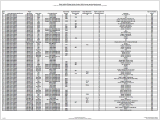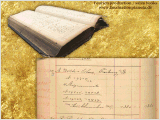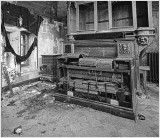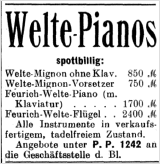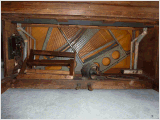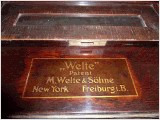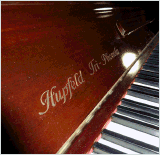List of existent reproducing pianos
From ~1905-1930 the vast majority of reproducing pianos incl. push-up players had been built. This is now more or less 100 years, one/two world-wars and economic crises ago. There are many reasons why reproducing pianos as well as the piano rolls disapeared. Today there is no summerized overview on how many reproducing pianos have survived.
We started a research to compile a list with all existent instruments [Welte-Mignon red, Welte-Mignon green, Hupfeld Phonola, Hupfeld-Clavitist, Hupfeld-Phonoliszt, Hupfeld-DEA und Hupfeld-Duo/Tri-Phonola, Aeolian DUO-ART (combined with Steinway), Philipps DUCA/Pianella as well as Ampico A, Ampico B and Welte Licensee Instrumente]. You will find the most recent issue of that list here [339 KB]
. We would very much appreciate any addition, tip or comment to further enrich this research! On this webpage you find some examples on where to find the hidden serial numbers of a reproducing instrument.
The main reasons for the drastic reduction of reproducing pianos are the following.
Feurich deliveries to Welte
We have read thru ca 60% of the Feurich documents. Some books are not accessible as they first have to be restored to be read / scanned. Nevertheless just now we have collected incredible details on the Feurich production being delivered to become a reproducing piano, i.e. Welte Mignon, Duca, Ducartist, Tri-Phonola, Stella, Dea, ...! Just with the appr. 60% of the data, impressive numbers show up: more than 1000 instruments for Welte delivered (655 cabinet, 270 Welte Pianos, 80 Welte grand pianos), more than 270 Duca instruments (10 cabinet, 215 Pianos, 55 grand pianos). These numbers will increase significantly, once we had a chance to see all the books. As we do not have the sales books of Welte or Philipps, we can't doublecheck if all these became instruments for sale. However we expect that nearly all of them did, as huge investments went into these. More details to come.
Welte instrument damaged
Most likely the majority of instruments got destroyed during the world wars. If not destroyed during the wars, the instruments often were damaged due to difficult conditions in the months after the wars (humidity, demolation of ruins, used as firewood, etc.). Very often the instruments didn't operate any longer due to damages, in the absence of experts to assess the instruments' situation properly, the player mechanism often got removed and dumped. Fortunately the Ampico-, Duo-Art- und Welte-Lic instruments in the US were not affected.
Distress sale of instruments
Another driving factor in diminishing numbers of reproducers was the economic crises in the 1920ies as well as the trend that pianos got out of date as a symbol for wealth. Pianos and player piano no longer reprensented the style to enjoy music - Radio, Grammophone etc. replaced them in many places. The availability of automobiles to a broad part of the society at lower cost than a reproducing piano also reduced the number of instruments. Repoducing pianos got sold at very low prices - many dealers had their stores full of beautiful instruments, desparately looking for buyers.
Stripping Pianolas...
After 20-30 years of use or even non-use, the player pianos showed technical problems and insufficient funtion. This was often the trigger to put the instruments away (storage, garage, etc.) or to strip of the player mechanism and to use the piano as a standard piano. This was another key driver of reducing the number of reproducing instruments. Today the majority of existent reproducing pianos can be found in museums and a t private collections. There are not many professional dealers any more, that focus on reproducing pianos. On very rare occasions still today instruments pop up from private (often initial) ownership.
First findings on serial numbers...
Comparism of production numbers...
Unfortunately there are no exact production figures of the respective manufacturers like Welte, Hupfeld, etc., therefore we can't put the number of existent instruments into perspective. With pianos, grand pianos and cabinets we can use the piano serial number to determine the year of production. Using that information we can find a correlation to the production numbers of the player mechanisms.
Distribution of the instruments...
Even if the list currently just represents a smaller part of the existent instruments, we started to look for first findings. With the approx. >100 Welte as well as >100 Hupfeld instruments identified we can have a closer look at the distribution in terms of: geografy, ownership, style, type, etc.. Certainly the data collection is a little easier to me in Germany - nevertheless the we find just under 50% of the identified instruments in Germany. That might probably also represent the share of sale at that time. Out of the identified Welte instruments there is a little more that 30% located in museums. As soon as we have the opportunity to look into every depot of a museum that figures will most likely rise. Out of the identified Welte instruments, there are a little more than 25% push-up players, some 10% Welte-Mignon cabinets, ~30% upright pianos and ~30% grand pianos. It's not a surprise to see approx. 80% of the Wetle instruments being Welte red (T100), as there were not too many sold after the introduction (1924) of the Welte green (T98).
Sequence of serial numbers...
Once the instruments are listed by the year of production as determined by the piano serial number, we can see that the sequence of serial numbers of the player mechanisms is sometimes mixed-up. This is nothing that surprises, since during production it was often the case, that Pianos as well as player mechanisms were brought forward or parked. Even if there are some runaway values in the list, it can be seen an ascending row of production numbers of the player mechanisms.
First findings on Welte serial numbers...
Appraisal of serial numbers: WELTE reproducing instruments
In addition to the already mentioned findings above, we can put forward some findings and hypotheses on the sequences of serial numbers. So far the oldest identified Welte-Mignon instrument is a Feurich-Welte-Cabinet with the Feurich serial number 18686 and the Welte serial number (cabinet number) 1322 of 1906. In the article of Hans-W. Schmitz "Die Stückzahlen der Welte Instrumente" anothern Welte-Mignon Cabinet is mentioned with a cabinet serial number 640, which would then be even older (1905). The highest Welte serial number being found so far is 7216 with a Blüthner-Welte grand piano (Blüthner serial number 114669) of 1929. Welte-Mignon push-up player often have another serial number in front of the wind motor. This seems to be a separate counting for push-up players. On the backside of each push-up player there is the Welte-Mignon cabinet number to be found. This Welte cabinet number seems to be the consecutive serial number of all Welte-Mignon instruments, may it be cabinet, pushup player, upright or grand piano. Taking the analysis by Durward R. Center "Welte Orchestrion - Jahre der Fülle" into account, Welte obviously used just one numbering system for all Orchestrion and Welte-Mignon instruments - maybe even the Welte philharmonic organ (needs to be investigated). Durward R. Center shows a list with known serial numbers of Orchestrions, that had also been dated by other remarks in the instrument, such as:
serial number: 57 (1893)
serial number: 659 (1905)
serial number: 2816 (1910)
Comparing that with i.e. the Welte-Mignon cabinet serial numbers of instruments that can be dated rather exactly by the piano serial number as shown in my list, it can be seen, that this ligns-up in a sequence.
serial number of the Feurich-Welte cabinet: 1322 (1906)
serial number of another Feurich-Welte cabinet: 2821 (1909)
serial number of a Steinway-Welte cabinet: 3718 (1912)
Also the examples of identified cabinet serial numbers of Welte push-up players join into this sequence of numbers.
It is important to know, that pianos being built by i.e. Feurich or Steinway got their piano number early in the production process (usually during so-called marriage of frame and "Raste" (German)). After being finished they got shipped to Welte (Freiburg) to get the player mechanism built in. Therefore it is comprehensible that the serial number of the piano manufacturer is up to ~one year earlier than the Welte entry.
Subject to further investigation is, how many Welte-Mignon instruments have actually being built. Hans-W. Schmitz' analysis ends with a good estimate of 4200 Welte-Mignon instruments. Taking the 7216 number of the Blüthner-Welte grand piano as one of the last serial numbers, and assuming that less than ~1500 Welte Orchestrions (and organs, if younted the same way) have been built, it might very well be, that 5000-6000 Welte-Mignon instruments might have been built. Without further data analysis this of course is just a hypothesis.
First findings on Hupfeld serial numbers...
Appraisal of serial numbers: Hupfeld Phonola instruments
With Hupfeld DEA, Phonola, Duo- und Triphonola a larger number of different piano manufacturers can be found which provided their instrumets to Hupfeld. Again, taking the piano serial number is a way to determine the year of manufacturing rather precisely. The so-called Hupfeld "Apparate" numbers, which are the numbers on the instruments added by Hupfeld, do also join into an ascending sequence of numbers. Deviations at some single numbers are easily explained by ad hoc changes during production. Most likely also Hupfeld had a continous numbering system for all their instruments incl. push-up players. The lowest number identified so far is 2168 with a very early Hupfeld Phonola push-up player. The highest number being identified is 55832 with a Phonola (88) piano.
Based on the research so far, it is conspicuous that by far less DEA, DUO- and Tri-Phonola reproducing instruments are existent. This might very well be another indication for the assumption that Hupfeld did not at all catch up with the market leader Welte at that time. In addition it is very likely that over the decades a Hupfeld reproducing piano did not survive because it had not that famous name as Welte - and dealers and/or private persons simply got rid of such an instrument instead of restoring it. The market success of Hupfeld was much more the Phonola push-up player (73), the Clavitist pianos as well as the Orchestrions. Hupfeld mentioned in an advertisement a production scale of more than 1000 Phonola push-up players every year during 1902-1913. Even with that large number of Phonola instruments the 5 digit production number of 55xxx seems to be pretty high. Subject to further investigation will be to find out, whether Hupfeld probably skipped number parts to differentiate between push-up players and pianos - maybe they started at a number of 30000 with numbering their pianos. In any case Hupfeld as the largest European manufacturer of automatic instruments manufactured an extremely large number of instruments. More findings to come as soon as research and analysis has proressed.

